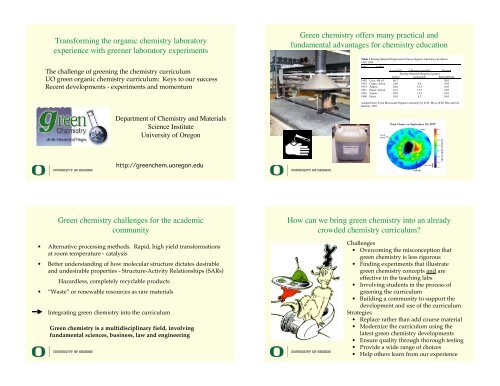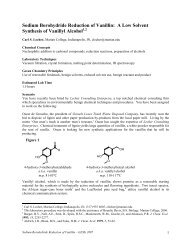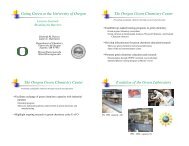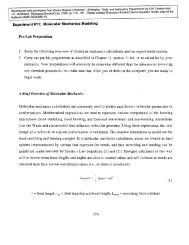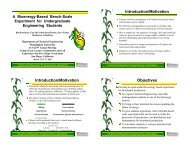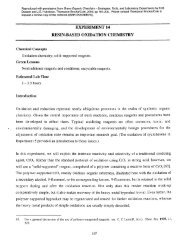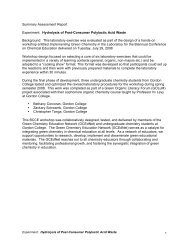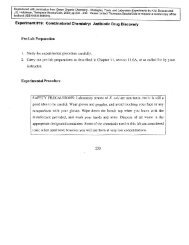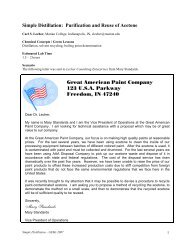Power Point Presentation (PDF) - Green Chemistry Center
Power Point Presentation (PDF) - Green Chemistry Center
Power Point Presentation (PDF) - Green Chemistry Center
You also want an ePaper? Increase the reach of your titles
YUMPU automatically turns print PDFs into web optimized ePapers that Google loves.
Transforming the organic chemistry laboratory<br />
experience with greener laboratory experiments<br />
The challenge of greening the chemistry curriculum<br />
UO green organic chemistry curriculum: Keys to our success<br />
Recent developments - experiments and momentum<br />
<strong>Green</strong> chemistry offers many practical and<br />
fundamental advantages for chemistry education<br />
Table 1 Starting Material Employed in Classic Organic Laboratory Syntheses<br />
1902-1980<br />
Date Author<br />
Acetanilide 4-Bromoacetanilide Benzoin<br />
Starting Materials Required (grams)<br />
Aniline Acetanilide Benzaldehyde<br />
1902 Levy, 4th ed. 46.2 50.0<br />
1915 Cohen, 3rd ed. 25.0 5.0 25.0<br />
1933 Adkins 28.0 13.5 10.0<br />
1941 Fieser, 2nd ed. 18.2 13.5 25.0<br />
1963 Adams 20.0 13.5 16.0<br />
1980 Drust 10.0 5.2 10.0<br />
Adapted from: From Microscale Organic Laboratory by D.W. Mayo, R.M. Pike and S.S.<br />
Butcher, 1985<br />
Department of <strong>Chemistry</strong> and Materials<br />
Science Institute<br />
University of Oregon<br />
http://greenchem.uoregon.edu<br />
<strong>Green</strong> chemistry challenges for the academic<br />
community<br />
• Alternative processing methods. Rapid, high yield transformations<br />
at room temperature - catalysis<br />
• Better understanding of how molecular structure dictates desirable<br />
and undesirable properties - Structure-Activity Relationships (SARs)<br />
Hazardless, completely recyclable products<br />
• “Waste” or renewable resources as raw materials<br />
• Integrating green chemistry into the curriculum<br />
<strong>Green</strong> chemistry is a multidisciplinary field, involving<br />
fundamental sciences, business, law and engineering<br />
How can we bring green chemistry into an already<br />
crowded chemistry curriculum?<br />
Challenges<br />
• Overcoming the misconception that<br />
green chemistry is less rigorous<br />
• Finding experiments that illustrate<br />
green chemistry concepts and are<br />
effective in the teaching labs<br />
• Involving students in the process of<br />
greening the curriculum<br />
• Building a community to support the<br />
development and use of the curriculum<br />
Strategies<br />
• Replace rather than add course material<br />
• Modernize the curriculum using the<br />
latest green chemistry developments<br />
• Ensure quality through thorough testing<br />
• Provide a wide range of choices<br />
• Help others learn from our experience
Process used to develop and teach greener<br />
laboratory procedures<br />
Assess existing<br />
procedure<br />
Identify hazards<br />
or inefficiencies<br />
Find/develop<br />
alternative methods<br />
Test efficacy<br />
of new procedure<br />
TRADITIONAL<br />
H<br />
GREENER<br />
H<br />
A safer bromination of an olefin<br />
H<br />
Br H<br />
+<br />
CCl<br />
Br 4 or CH 2Cl 2<br />
2<br />
H<br />
1. HBr<br />
2. 30% H 2 O 2<br />
ethanol, reflux<br />
H<br />
H Br H<br />
ethanol<br />
H<br />
GREEN<br />
ethanol<br />
N H Br 3<br />
N H Br + Br 2<br />
H<br />
Br<br />
Br<br />
We teach this simple process to<br />
our students as we implement it.<br />
<strong>Green</strong>er<br />
alternative<br />
Laboratory Skills:<br />
<strong>Green</strong> Lessons Taught:<br />
Reaction set-up<br />
Less toxic solvents can be selected<br />
Vacuum filtration<br />
Hazardous reagents can be generated in situ<br />
Melting point determination<br />
Djerassi, C; Scholz, C.R. J. Am. Chem. Soc. 1948, 70, 417.<br />
Reed, S.M.; Hutchison, J.E. J. Chem. Ed. 2000, 77, 1627-1629.<br />
McKenzie, L. C.; Huffman, L. M.; Hutchison, J. E. J. Chem. Ed. 2005, 82, 306-310.<br />
Analysis using green metrics<br />
• Appropriate metrics for teaching laboratories:<br />
– Enhance student safety<br />
– Reduce the volume and hazard of the wastestream<br />
– Ease reliance on environmental controls<br />
– Improve reaction efficiency<br />
• Atom economy, percent experimental atom<br />
economy, E factor, effective mass yield<br />
McKenzie, L. C.; Huffman, L. M.; Hutchison, J. E. "The evolution of a green<br />
chemistry laboratory experiment greener brominations of stilbene," Journal of<br />
Chemical Education 2005, 82, 306-310.<br />
O<br />
Solventless Aldol Condensation<br />
mp 40-42 oCmp 42-45 oCmp 178 - 181 ° C<br />
Chemical Concepts:<br />
Melting point determination<br />
and depression<br />
Aldol condensation reaction<br />
Recrystallization skills<br />
+<br />
O<br />
1. NaOH<br />
2. H 3 O + workup<br />
OCH 3<br />
OCH 3<br />
H 3 CO OCH 3<br />
<strong>Green</strong> Lessons:<br />
Solventless reactions<br />
Atom economical reactions<br />
Rothenberg, G.; Downie, A. P.; Raston, C. L.; Scott, J. L.<br />
J. Am. Chem. Soc. 2001, 123, 8701-8708.<br />
Raston, C. L.; Scott, J. L. <strong>Green</strong> <strong>Chemistry</strong> 2000, 2, 49-52.<br />
O
Liquid CO 2 as a green extraction solvent<br />
Liquid CO 2 extraction in the teaching laboratory<br />
Traditional Method<br />
Orange Peel<br />
<strong>Green</strong> Method<br />
Orange Peel<br />
Steam distill<br />
and/or<br />
Organic solvent<br />
CO 2 (liquid)<br />
No organic solvent<br />
D-limonene<br />
Chemical Concepts:<br />
Solid/liquid extraction<br />
Natural products (terpenes)<br />
Spectroscopy<br />
Phase transitions<br />
<strong>Green</strong> Lessons:<br />
Use of safer solvents<br />
Prevention of waste<br />
<strong>Green</strong> materials processing<br />
McKenzie, L. C.; Thompson, J. E.; Sullivan, R.; Hutchison, J. E. "<strong>Green</strong><br />
chemical processing in the teaching laboratory: A convenient liquid CO 2<br />
extraction of natural products," <strong>Green</strong> Chem. 2004, 355-358.<br />
<strong>Green</strong> Organic <strong>Chemistry</strong> Laboratory Manual<br />
Target audience: Sophomore-level organic<br />
chemistry laboratory<br />
• Introduction<br />
• Identification of Chemical Hazards<br />
• Chemical Exposure and<br />
Environmental Contamination<br />
• Evaluation of Chemical Hazards<br />
• Introduction to <strong>Green</strong> <strong>Chemistry</strong><br />
• Alternative Solvents<br />
• Alternative Reagents<br />
• Reaction Design and Efficiency<br />
• Alternative Feedstocks and Products<br />
Plus 19 <strong>Green</strong> Organic <strong>Chemistry</strong> Experiments<br />
Laboratory curriculum project implementation<br />
250<br />
200<br />
150<br />
100<br />
Fall term 2003<br />
Synthesis, separations, spectroscopy<br />
1. Solventless Aldol condensation<br />
2. Bromination of an alkene<br />
3. Preparation/distillation of<br />
cyclohexene<br />
4. Synthesis of adipic acid<br />
5. Oxidative coupling of alkynes<br />
6. Gas phase porphyrin synthesis<br />
7. Solvent effects on kinetics<br />
8. Molecular mechanics modeling<br />
50<br />
0<br />
97-<br />
98<br />
98-<br />
99<br />
99-<br />
00<br />
00-<br />
01<br />
01-<br />
02<br />
04-<br />
05<br />
Number of<br />
Students<br />
Winter term 2004<br />
Synthesis, spectroscopy, applications<br />
1. Electrophilic iodination with KI/NaOCl<br />
2. Palladium-catalyzed aryl halide/alkyne<br />
coupling<br />
3. Polymer-supported oxidation chemistry<br />
4. Friedel-Crafts acylation of ferrocene<br />
5. Thiamine-mediated benzoin condensation<br />
6. Self-assembled monolayers/patterning<br />
7. Combinatorial synthesis of antibiotics
The approach changes the way students think about<br />
chemical hazards and chemistry<br />
"After taking this course I have a much better opinion of chemistry .... I feel like<br />
I am learning something that has an actual important application to the real<br />
world."<br />
"I have decided to get a minor in chemistry so I can make more conscious<br />
decisions regarding chemistry and avoid destructive practices for my health or<br />
the environment."<br />
• Teaches students a rational procedure for analyzing/minimizing<br />
hazards<br />
• Empowers students to use chemistry to solve environmental<br />
problems - "Ambassadors of <strong>Green</strong> <strong>Chemistry</strong>"<br />
• Changes the way students and society view chemicals, chemistry<br />
and chemists - "Know the hazards, not all chemicals are hazardous"<br />
Our experience introducing green chemistry - there<br />
are many incentives<br />
We are generating less waste and a less hazardous waste stream.<br />
Winter term disposal numbers (14.2L of aqueous, 1L of flammable<br />
organic and 1kg of solid waste for 180 students)<br />
The project has been great for University public relations<br />
More than 20 articles have now been published around the world<br />
Enhances student recruiting<br />
We have seen strong interest from undergrads and grads who want to<br />
be part of green chemistry<br />
Opportunity to upgrade curriculum and facilities<br />
University invested in a showcase lab facility to highlight the program<br />
Improved educational atmosphere<br />
The new lab setting is an excellent learning environment<br />
The new green chemistry lab<br />
<strong>Green</strong> chemistry offers many practical and<br />
fundamental advantages for chemistry education<br />
Table 1 Starting Material Employed in Classic Organic Laboratory Syntheses<br />
1902-1980<br />
Date Author<br />
Acetanilide 4-Bromoacetanilide Benzoin<br />
Starting Materials Required (grams)<br />
Aniline Acetanilide Benzaldehyde<br />
1902 Levy, 4th ed. 46.2 50.0<br />
1915 Cohen, 3rd ed. 25.0 5.0 25.0<br />
1933 Adkins 28.0 13.5 10.0<br />
1941 Fieser, 2nd ed. 18.2 13.5 25.0<br />
1963 Adams 20.0 13.5 16.0<br />
1980 Drust 10.0 5.2 10.0<br />
Adapted from: From Microscale Organic Laboratory by D.W. Mayo, R.M. Pike and S.S.<br />
Butcher, 1985
Next steps<br />
More labs!<br />
Disseminate our and other’s labs via the GEMs<br />
database<br />
Promote the community through workshops,<br />
symposia and collaborations<br />
Build the “business case” for green chemistry<br />
Workshop participants 2001-present<br />
Addressing the case for green chemistry<br />
“<strong>Green</strong> chemistry will be more expensive”<br />
Must carefully consider costs of reagents, solvents, disposal, engineering<br />
controls, new labs, etc.<br />
“There are no lab exercises available and I don’t have time to develop my own”<br />
A wide range of experiments are now in development around the<br />
country. There should be a lot of choice soon.<br />
“There is no room in the curriculum for new material”<br />
Don’t add, replace.<br />
“The curriculum will not train students to work with hazardous materials”<br />
Most students will not work with hazardous substances after organic.<br />
Don’t have to work with hazardous substances to learn proper technique.<br />
“<strong>Green</strong> is political, not scientific…green chemistry is not rigorous”<br />
Designing better products and better processes is what synthetic chemists<br />
do. <strong>Green</strong> chemistry provides a new challenge.
Acknowledgments<br />
Prof. Ken Doxsee<br />
Dr. Scott Reed<br />
Ms. Lallie McKenzie<br />
Mr. Marvin Warner<br />
Ms. Lauren Huffman<br />
Dr. Julie Haack<br />
Dr. Rob Gilbertson<br />
Mr. Gary Succaw<br />
Dr. John Thompson<br />
Ms. Kathryn Parent<br />
Ms. Anna Shope<br />
Dr. Leif Brown<br />
Mr. Gerd Woehrle<br />
and the Students of CH337G and CH338G<br />
The Alice C. Tyler Perpetual Trust<br />
The University of Oregon


